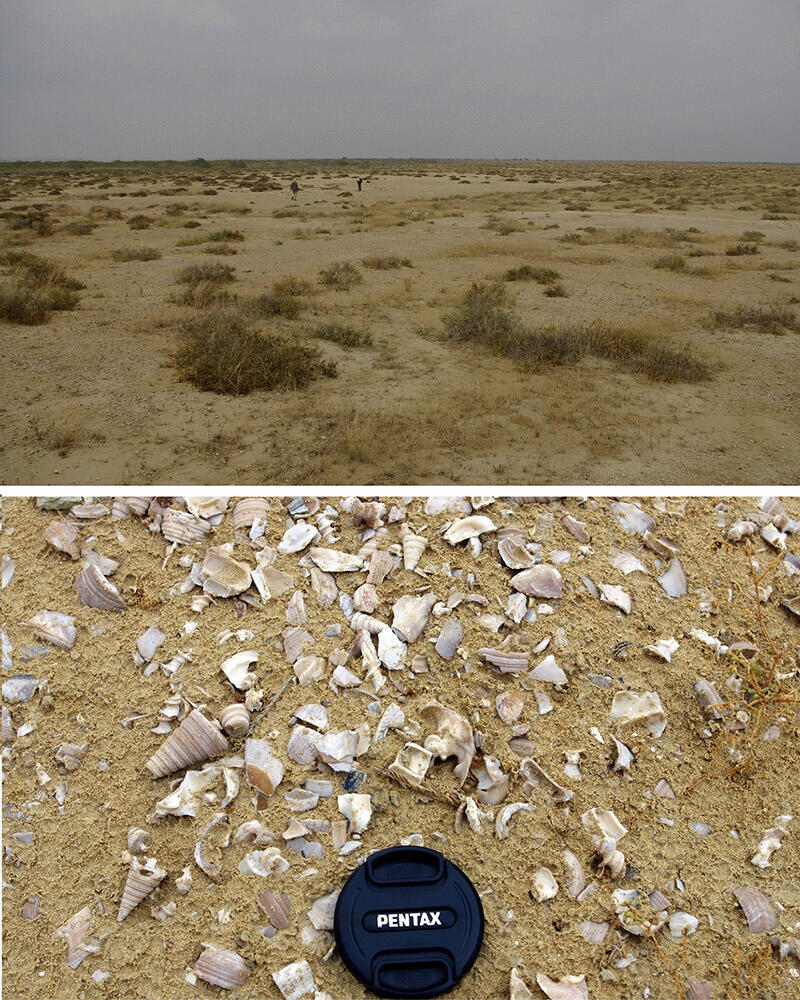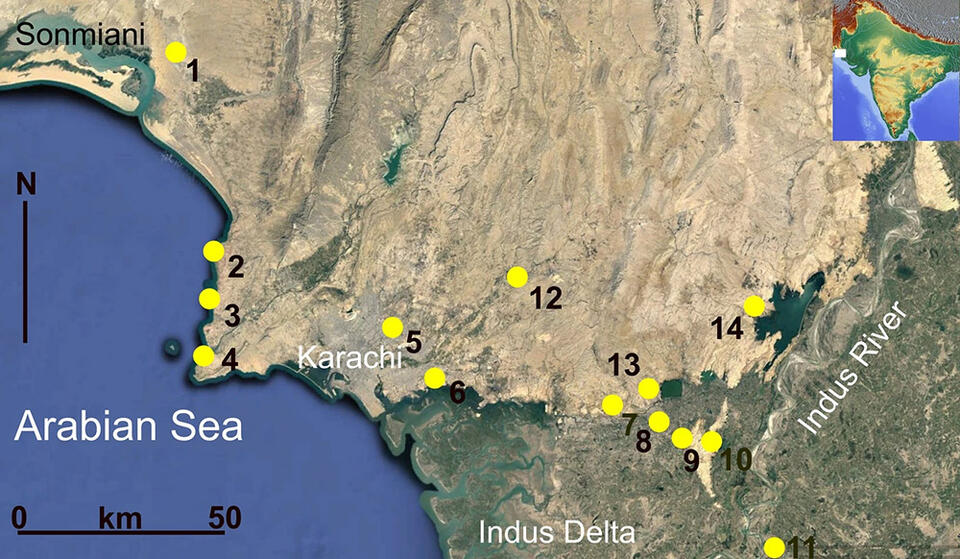This paper develops a key theme relating to the origins of the ancient Indus civilization – the very different geographical reality in the Indus delta and the Arabian coast in the millennia preceding its rise. Dr. Biagi's work, detailed here especially around Lake Siranda in Balochistan to the northwest of Karachi, show a once flourishing lake peopled by flint-using inhabitants in the 9th millennium BP (Before Present, so roughly 7000 BCE or more than 4,500 years before what is considered the height of the ancient Indus civilization). Indeed, the mangrove swamps on the coast, and the wetter and more fertile and deeper inland, often far from today's dry coastline, seem to have drawn settlers to the region that early and helped create the conditions that led to the later urban culture flourishing. Dr. Biagi is able to relate this to the rise of Amri culture:
"The radiocarbon dating of shell sites has been crucial also for the study of the Chalcolithic Amri phase, an important period of which very little is known. It is now becoming clear that the coast of Sindh and its related islands, Tharro Hill for example [71], played a very important role in the economic strategy of the Amri phase. Thanks to the data collected during the 2020–2022 surveys and a new series of radiocarbon dates, we can attribute the Chalcolithic shell middens discovered along the coast of Lower Sindh, Kalan Kot in the Makli Hills (Thatta) for example [24], to the 6th millennium BP Amri phase [64]. Though we still know very little about Amri, its origin and disappearance [68], several Amri fortified settlements and shell middens, have been discovered close to the coastline and on small islands, suggesting that the subsistence economy of the sites of this aspect was partly oriented toward the sea," (p. 11).
Indeed it should be noted that the research outlined here is very recent, and is yet to be fully absorbed by wider archaeological scholarship in general, even if it is in other ways the fruit of decades of research by Dr. Biagi and his Italian and Pakistani colleagues literally treading for miles across the landscape of southern Pakistan looking for tiny clues - shell middens, flint stones cut a certain way, rocks in small circles and other minute tell-tale signs of human habitation. At the same time, this is a battle against time, for as Dr. Biagi notes "Unfortunately, many of the sites described in this paper and those discovered by Professor AR Khan in the 1970s, have been destroyed or damaged during the last thirty years due to population growth, industrial development and uncontrolled expansion of residential centres," (p. 10).
As usual, discoveries in one area lead to more questions and the need for investigations elsewhere: "Recently, T. palustris shell middens and knapped stone artefacts have been discovered in Khadir Island (Gujarat, India) [86], not far from the Bronze Age Indus metropolis of Dholavira [87]. This discovery shows that Neolithic shell middens, radiocarbon-dated to the second half of the 7th millennium BP, are present also in other regions of the northern coast of the Arabian Sea. Research currently underway in the Rann of Katchchh should tell us if there is any relationship between these sites and those of the coast of Lower Sindh," (p. 10). They also point once again to the dramatic role of environmental ecology in the arc and development of habitation and later civilization in these areas: "The shell sites discovered along the shores of Lake Siranda show that the landscape of Las Bela changed drastically between the beginning of the Neolithic and the Bronze Age when the lagoon was no longer connected to the Arabian Sea for various reasons including river aggradation and accumulation of aeolian sediments along its shores [48]. The events that took place in Las Bela during this period, can be compared with those of the coast of Oman [14, 15], while the situation in Sindh is still under study," (p. 11).
This research adds to the understanding of the archaeological and environmental history of the Arabian Sea's northern coastline, offering insights into the patterns of human settlement, cultural transitions, and environmental changes that have shaped this region throughout the Holocene. It also offers guidelines for future research - before it is too late.
Image: 1. Siranda Lake: Distribution map of the radiocarbon dated sites: 9th millennium BP (violet dot), 8th millennium BP (white dots), 7th millennium BP (red dots), 6th millennium BP (blue dots), 5th millennium BP (green dots), historic dates (black dots) (drawing by P. Biagi)
2. Siranda Lake: General view of Site SRN-28 taken from SRN-29 (top), with T. telescopium fragments on the site’s surface (bottom) (photographs by P. Biagi, 2013)




